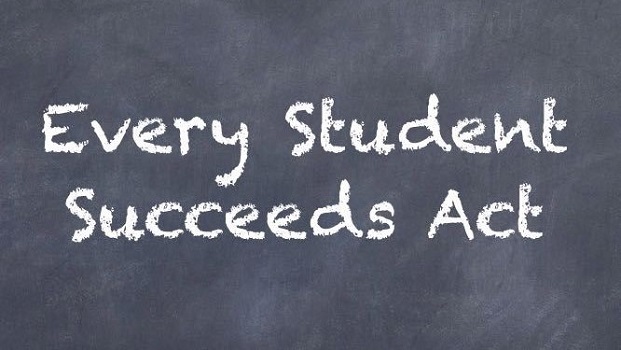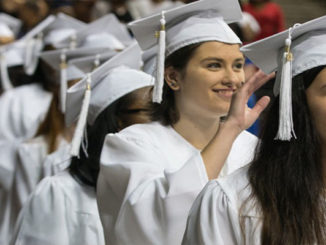
In December 2015, the education world in Washington, D.C., crowded into the Eisenhower Executive Office Building’s auditorium at the White House to celebrate President Barack Obama’s signing of the Every Student Succeeds Act, the long-overdue overhaul of No Child Left Behind. The typical overheated political praise flowed, punctuated with a lot of selfies that quickly became ubiquitous on education social media. And with the Republican Party imploding and Hillary Clinton a sure bet to win the White House, education policy seemed to be on a smart and happy glide path.
Now, just two years later, you’re hard-pressed to find a Democrat who wants to own up to being at the scene of the crime. The same people who toasted the genius of the Obama team in passing such a clever law now ask where the accountability is. (Remember a couple of years ago when former secretary of education Arne Duncan told Politico, “Candidly, our lawyers are much smarter than many of the folks who were working on this bill.”) Yes, some derided the law in private, but few had the guts to say so publicly. But it’s the same law; the only thing that’s changed is who is at the helm at the Department of Education. So, unsurprisingly, here we are.
And, now, 2018 will be ESSA’s most important year yet.
After a rough start, Education Secretary Betsy DeVos, to her credit, is making states do more than staple together a few pages to get their ESSA plans approved. But her hands are tied by the law’s requirements. She’s much more interested in school choice than accountability policy, and she’s part of an administration that is not going to antagonize powerful Republicans on Capitol Hill over the n-sizes of student subgroups in accountability plans.
That the ESSA law doesn’t do much is by design rather than a flaw, from the point of view of most Republicans, and it’s in line with how they see the proper federal role in K-12 education. Their propagandists romanticize the states despite ample history suggesting otherwise on education. Honest conservatives admit the unevenness a weak federal role will lead to, but argue, and not without some evidence, that the alternative — prescriptive federal rules — is even worse education policy.
But for now, all we have are the plans. They have attracted a great deal of attention and analysis but are just that: plans. Dwight D. Eisenhower reminds us that while plans are useless, planning is indispensable. Former professional boxer Mike Tyson famously noted that “everyone has a plan until they get punched in the mouth.” Both apply here in different ways.
One Beltway impresario groused last month that state ESSA plans were being obsessively reviewed by other “Beltway impresarios.” In some cases that might be true, and not all federal filings are created equal. Yet at Bellwether we worked with the Collaborative for Student Success and brought in dozens of experts, including former state officials and analysts with deep state policy experience to review all the state ESSA plans. It was a qualitative review so that states could get credit for how the pieces of their plans fit together to form a coherent whole, not just whether they had checked boxes.
These reviewers were unimpressed overall and saw most of the plans as real missed opportunities to improve equity and drive improvement. And there was consistency to the reviews. For instance, different sets of reviewers evaluated California’s draft plan as well as the plan the state ultimately submitted to the federal Department of Education. Their findings were similar across the board and echoed the concerns of a variety of interest groups in California. (The Department of Education has also raised concerns about California’s plan).
Yet as Bellwether principal Juliet Squire cautioned, channeling Ike more than Iron Mike, states use the ESSA plans for different purposes based on various leadership styles. So it’s wise not to be too deterministic. That’s why 2018 is when things start to get really interesting on ESSA. The state plans cease being exercises in planning and become live exercises in improving schools.
The mundane and predictable reality is that some states will exceed expectations while others will underperform even the low bar they have set.
If No Child Left Behind was overly ambitious about what we should expect from our sprawling system of public education, then the Every Student Succeeds Act has revealed just how pervasive “the soft bigotry of low expectations” truly is. It’s a “Game of Thrones” approach to schooling — the side of the wall you happen to live on has a lot to do with your life chances.
Traditionally the federal government has tried to hedge against pervasive inequity by putting in place some guardrails, but a combination of politics, fatigue, and federal overreach has led to a bipartisan consensus to throw in the towel on accountability. Now it truly is on the states.
Going forward, a few things warrant watching. First, evaluating the plans is important but is just one step. As Squire notes, states may have different strategies up their sleeve, so what they do now warrants close examination and even more weight than what they say they will do. States with bold plans may underwhelm, while states with weaker plans on paper may surprise. In addition, there is now a 50-state natural experiment unfolding. We should learn from it to inform future policy and practice efforts. The idea that there will be no bright spots is as myopic as the idea that left to their own devices, all the states will do right by historically underserved students.
Second, there are always unintended consequences. Will the ESSA era lead to more involvement in local schools and a greater assertion of “voice” in education rather than “exit” — to borrow from A.O. Hirschman’s famous framework? Or, conversely, will parents realize that if national policymakers are running up the white flag on really making public schools better, they ought to get out as well? Will these conditions create the moment that personalized learning can emerge as a transformative education technology, or will the lack of emphasis on results allow ideas like personalized learning to flourish with scant attention to quality?
Finally, who are the leaders who will emerge from this? Will a governor seize this opportunity to plow new ground as a bipartisan group of Southern governors did in the 1980s, or will enterprising state chiefs blaze new paths? Or will, as some fear, a stagnation set in that leaves a generation of young people ill-prepared for a fluid globalized economy?
Here at The 74 we plan to track all of that and delve into what states are actually doing as ESSA plays out in the nation’s schools.
Andrew J. Rotherham is a co-founder and partner at Bellwether Education, a national nonprofit organization working to support educational innovation and improve educational outcomes for low-income students. He is a senior editor at The 74 and serves on the 74’s board of directors. In addition, among other professional work, he is a contributing editor at U.S. News & World Report, writes the blog Eduwonk.com, teaches at The University of Virginia and is a senior advisor at Whiteboard Advisors.



